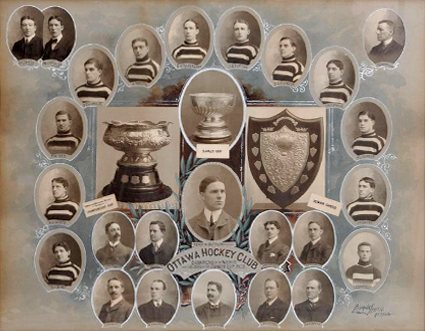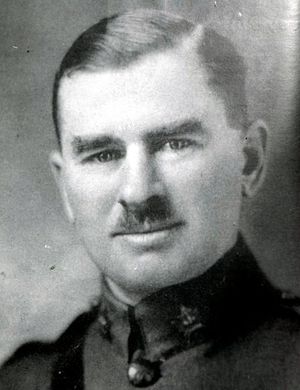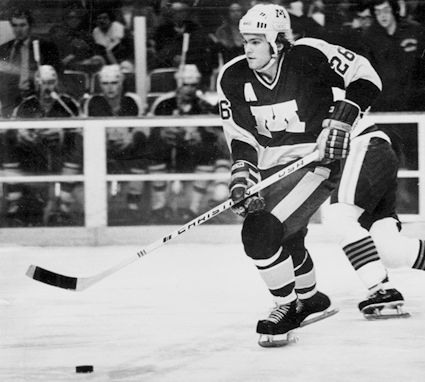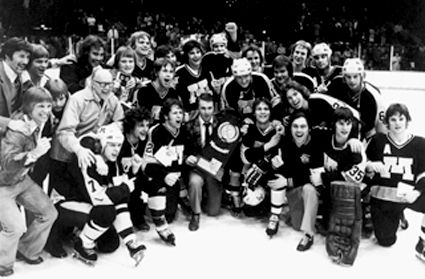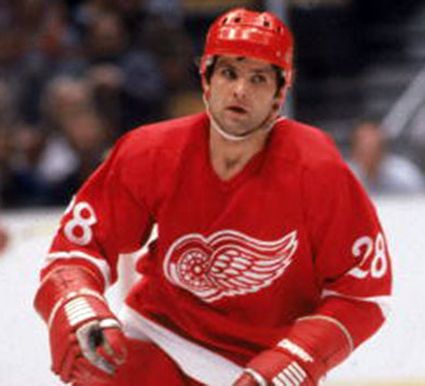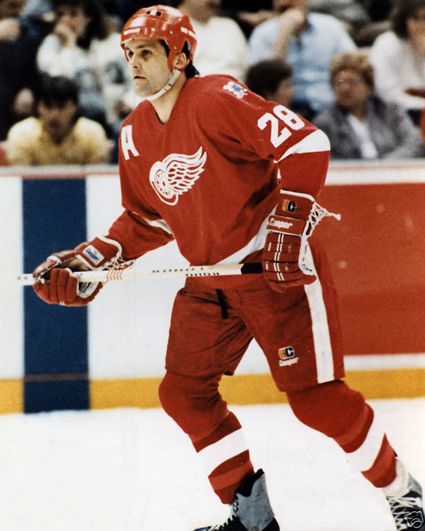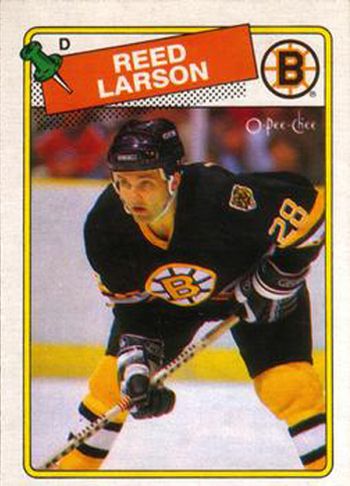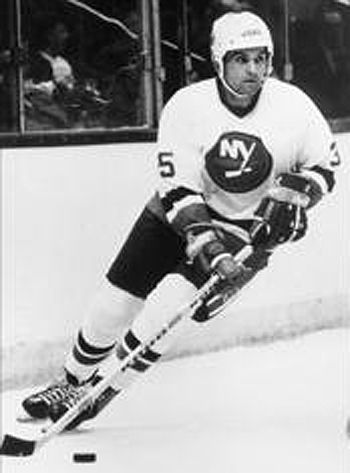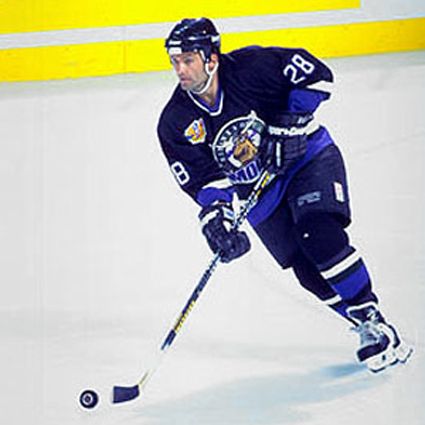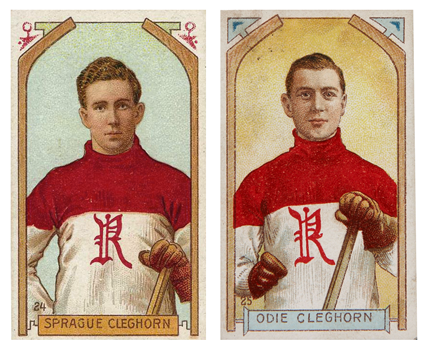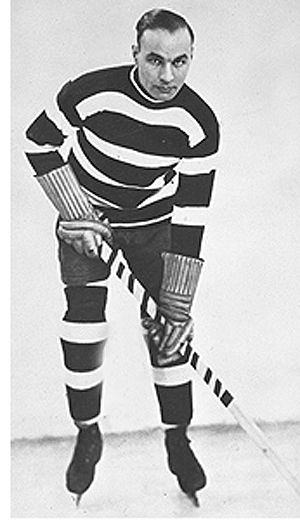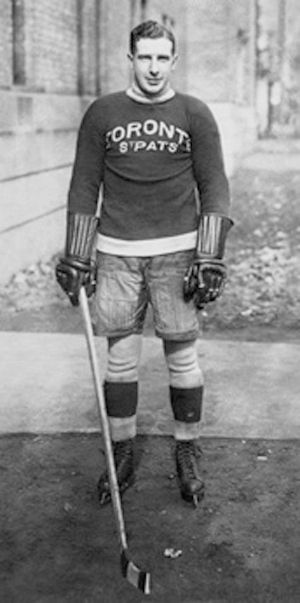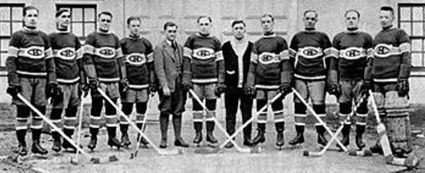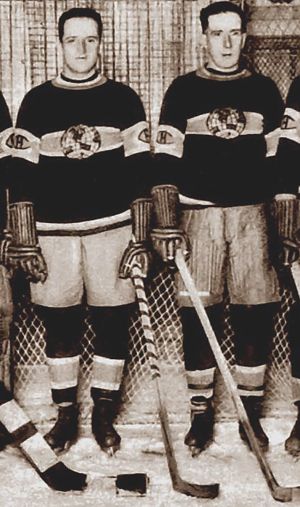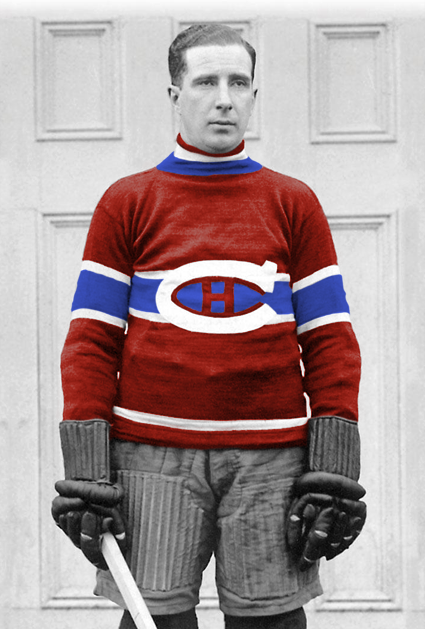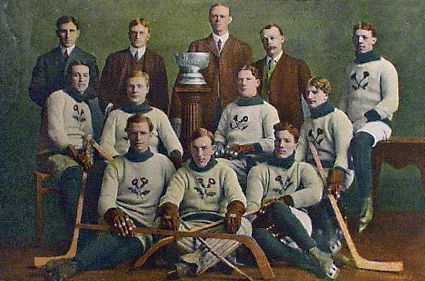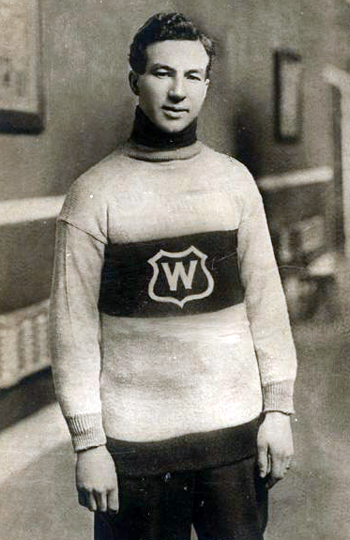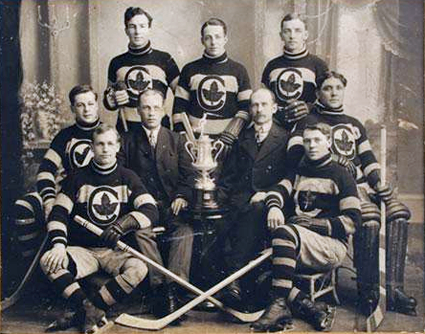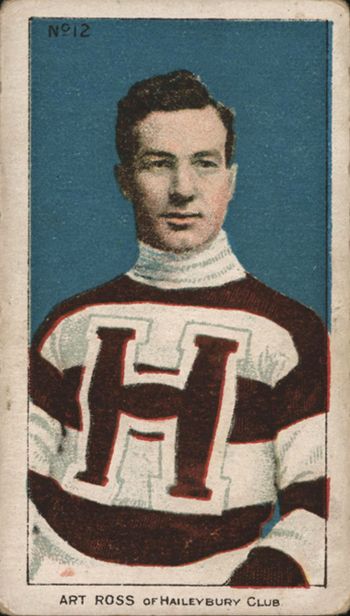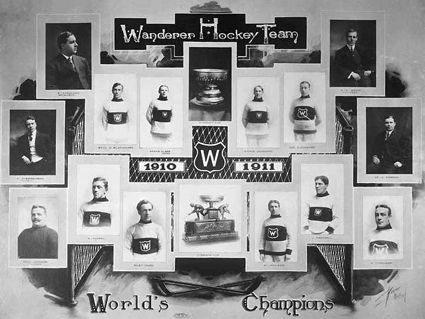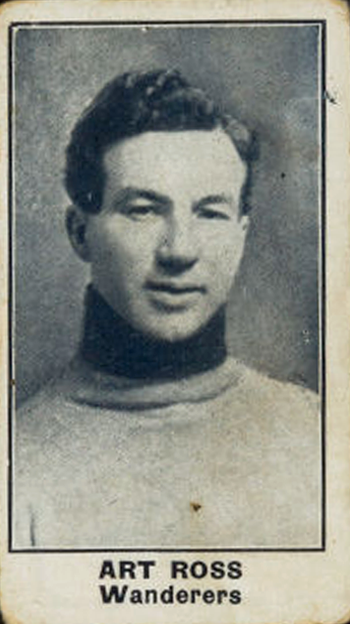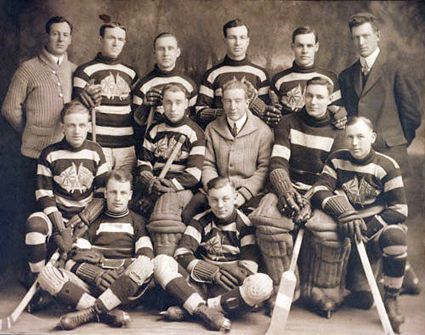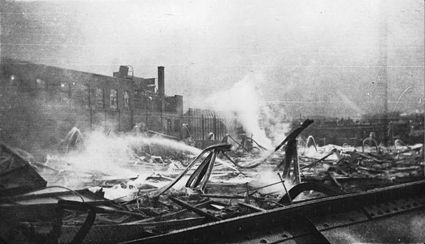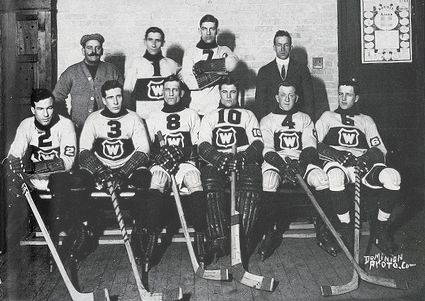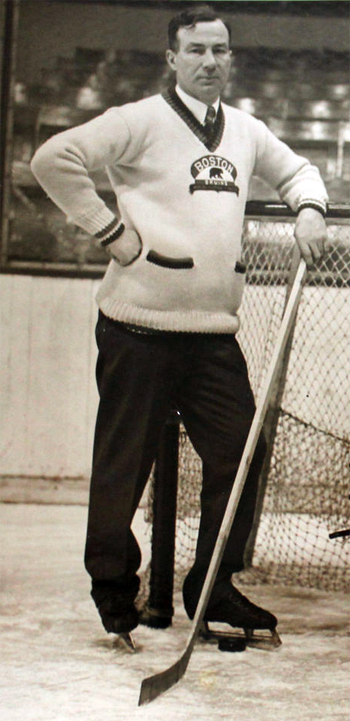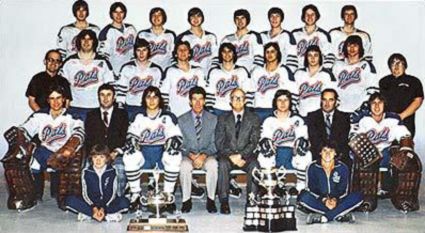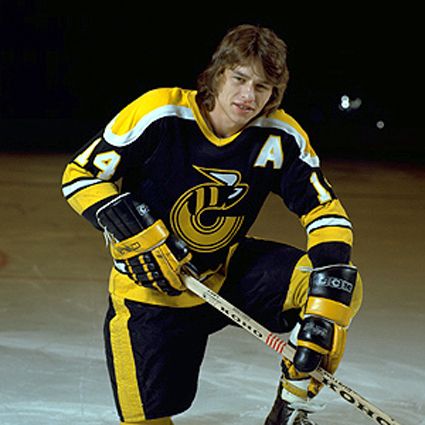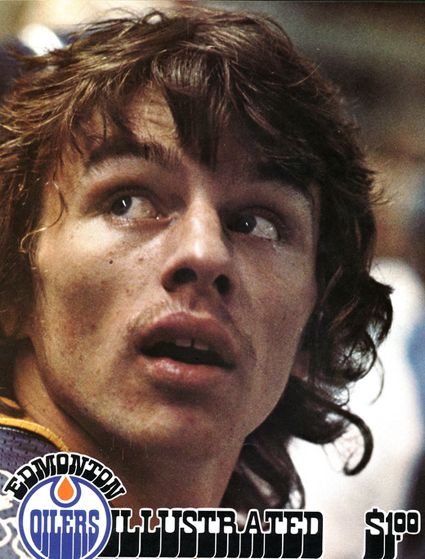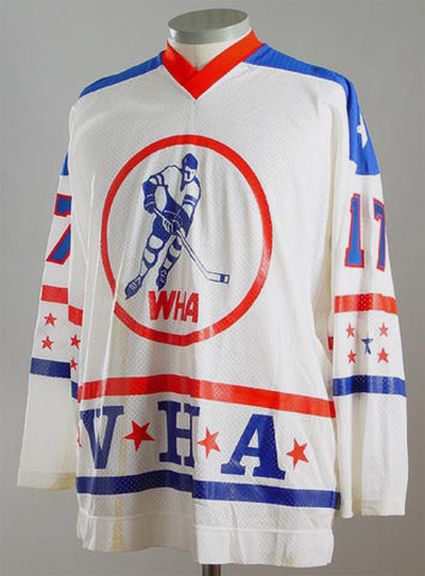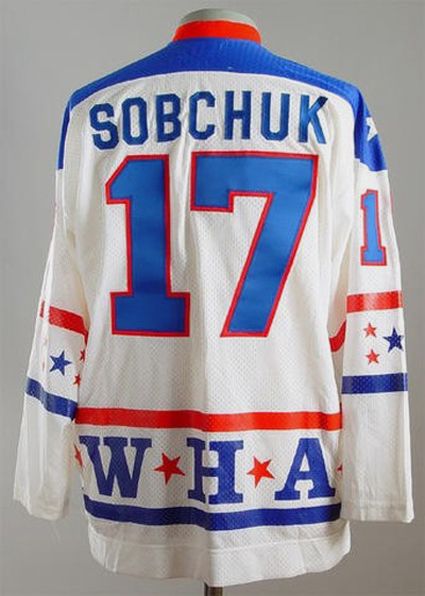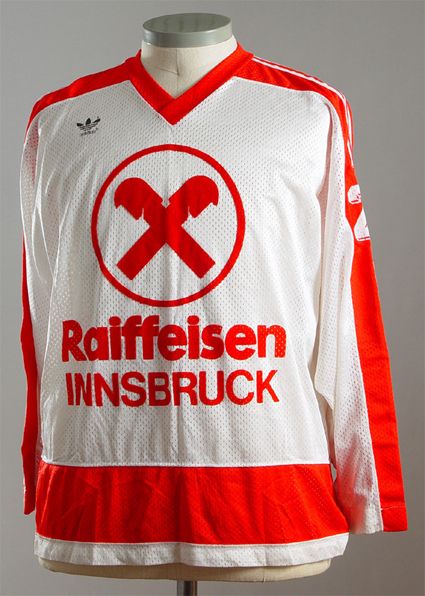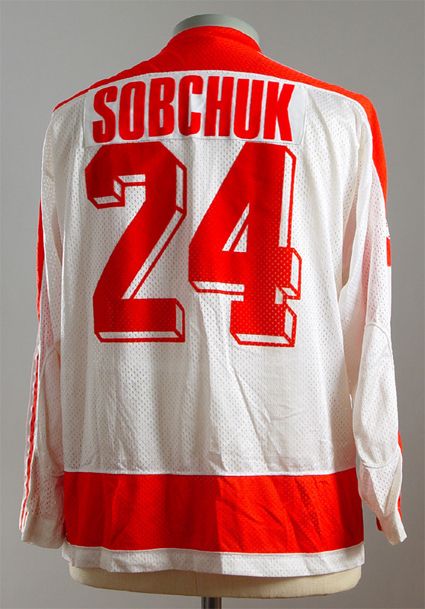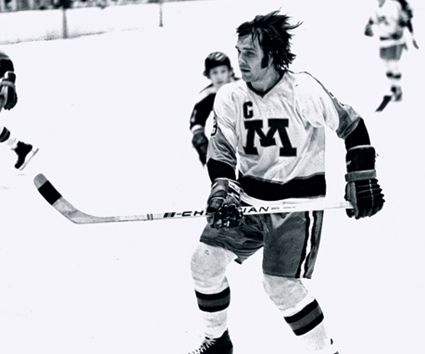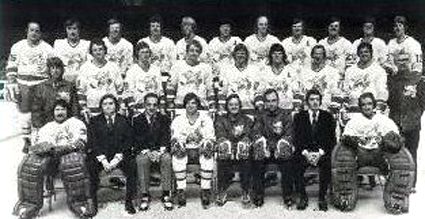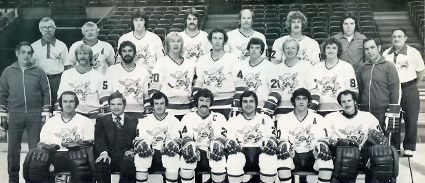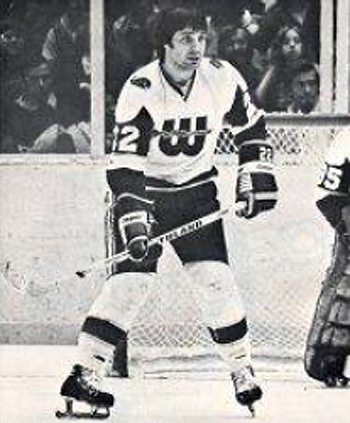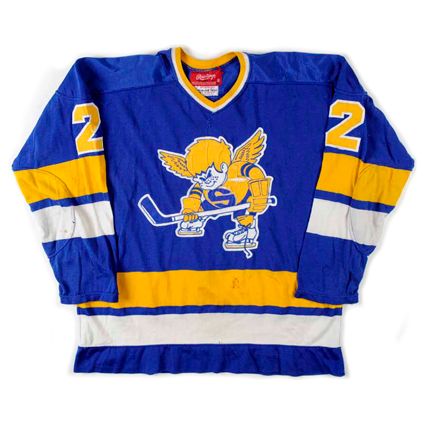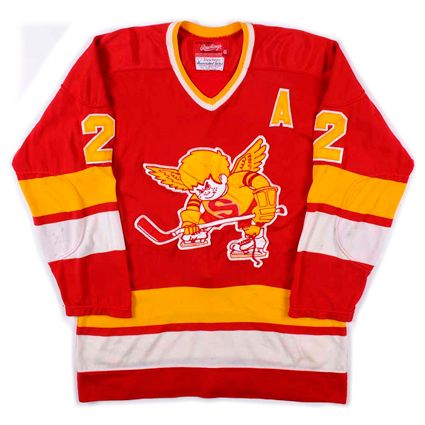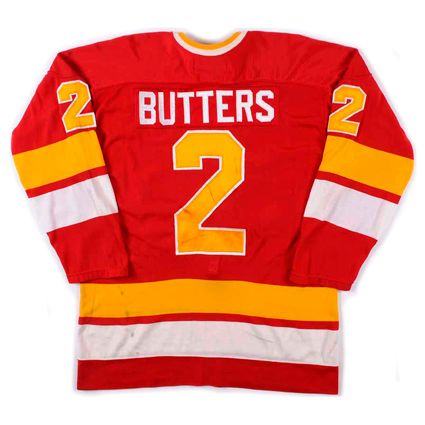Saturday, January 16, 2016
1905 Ottawa Silver Seven Frank McGee Jersey
Born in 1882, Frank McGee excelled at sports, rowing, playing lacrosse and rugby, which included winning a Canadian championship in 1898. But what McGee is best remembered for was his goal scoring prowess at hockey.
In 1900, at the age of 17, while playing in a charity exhibition game with a local Canadian Pacific Railway team, McGee permanently lost the sight in one eye when hit with a high stick. He quit playing to become a referee, but quickly returned to playing despite the risk of losing the vision in his remaining good eye.
After playing junior and intermediate level hockey in his native Ottawa, he joined the Ottawa Hockey Club for the 1903 season. He appeared in six of the club's eight games and immediately showed his offensive skills with 14 goals to place second overall in the Canadian Amateur Hockey League.
In the CAHL playoffs, McGee and Ottawa faced off against the Montreal Victorias in a two-game total-goal series for the rights to the Stanley Cup. Game 1 finished tied at 1-1, with McGee held scoreless. Ottawa roared to life in Game 2, however, as McGee led the Ottawa onslaught with a hat trick as they overpowered the Victorias 8-0. As a result of their 9-1 triumph, Ottawa became league champions were declared holders of the cup for the first time in club history.
Two days later the new champions were challenged for their new trophy by the Rat Portage Thistles in a best-of-three series. Game 1 went to Ottawa 6-2, with McGee scoring twice. Two days later, Ottawa successfully defended their trophy with a 4-2 win, with McGee scoring twice more, including the cup winning goal at 8:20 of the first half, as the game had yet to be divided into three periods. As a reward for their victory, each member of the squad would receive a silver nugget, which gave birth to the team's new nickname, The Silver Seven.
The Stanley Cup champion 1903 Ottawa Hockey Club
Before the 1904 CAHL season began, Ottawa faced another challenge for the Stanley Cup, this from the Winnipeg Rowing Club. A best-of-three series, play began on December 30th, 1903. When the series concluded on January 4, 1904, the Silver Seven prevailed after a 9-1 win, a 6-2 loss and a 2-0 shutout in Game 3.
Ottawa had a tumultuous 1904 season, as they withdrew from the CAHL after only four games and joined the new Federal Amateur Hockey League, but did not participate in any of the FAHL regular season games. In the four CAHL games Ottawa did compete in, McGee scored 12 times, which was still good enough to place him fifth in the final scoring totals.
After leaving the CAHL, the Silver Seven would face a cup challenge from the Toronto Marlboros, whom they would turn away 2 games to none in their best-of-three challenge in late February of 1904.
Once the FAHL regular season was concluded, it's regular season champions, the Montreal Wanderers met the Silver Seven to compete in a two-game, total-goal series for the FAHL championship and the rights to the Stanley Cup that went with it. At least that was the plan. The first game ended in a 5-5 tie when the Wanderers refused to play overtime with the same referee in charge and then had the temerity to demand the series begin anew as a best-of-three! When the trustees of the cup ordered the series to continue as planned, the Wanderers abandoned their challenge, leaving the Silver Seven as FAHL champions despite their having played but a single tie game in league competition! During the tie game, McGee added another goal to his career total.
A final challenge to Ottawa was arranged for one week later, this from Brandon Wheat Cities in another best-of-three format, which the Silver Seven turned away with a pair of victories. While McGee had only played in four regular season games during the 1904 season, he skated in eight cup challenge games, scoring 21 times as the Silver Seven turned away no less than four separate challengers.
In their first full season of FAHL competition in 1905, Ottawa came first with a 7-1 record as McGee would tie for the league lead with 17 goals, but he would score his while playing in two less games than Jack Marshall. The highlight of McGee's regular season would be a five goal performance on February 4th.
During the season, the Dawson City Nuggets would travel 4,000 miles from the Yukon to challenge Ottawa. Their trip would take a month to complete and include traveling on foot, by sled dog, automobile, ship and train. Game 1 of the best-of-three would go to Ottawa by a score of 9-2, with McGee scoring once. Game 2 on this date in 1905 would be one for the ages, as Ottawa continued to pile up goals at a furious pace, eventually winning by an unfathomable 23-2 final score with McGee setting a record which still stands today, as he scored an incredible 14 times! Eight of McGee's goals were consecutive and came in under nine minutes of playing time.
As league champions, Ottawa retained the cup and was challenged once again by the Rat Portage Thistles. McGee did not play in Game 1, which was won by the Thistles 9-3. McGee returned for Games 2 and 3, which were won by Ottawa 4-2 and 5-4 with McGee scoring three times.
The Stanley Cup champion 1905 Ottawa Silver Seven
For the 1906 season, the Silver Seven moved to the new Eastern Canada Amateur Hockey Association. They tied for the best record at 9-1. McGee was third in league scoring with 28 goals in seven games, which included an eight goal performance on March 3rd.
Ottawa would face two challenges during the regular season, first from Queen's University in a best-of-three. After Game 1 went the way of the Silver Seven 16-7, there was little doubt that the cup would change hands, which was confirmed by a 12-7 score in Game 2. McGee scored four times in Game 1.
Just prior to the end of the regular season, Ottawa again had to face a cup challenge, this from Smiths Falls in another best-of-three series. Ottawa had little trouble defending it's now three year grip on the Stanley Cup, as they won two straight by scores of 6-5 and 8-2. In all, McGee scored 15 times in the four cup challenge games that season.
The final two games of McGee's career came in the ECAHA playoffs on March 14th and 17th, 1906. The series was a two-game, total-goal affair. The Montreal Wanderers put in an early claim on the cup with a resounding 9-1 win in the first game.
Ottawa was down, but not out, as they entered Game 2, but 12 minutes in, Montreal scored again to increase their lead to nine goals. McGee got Ottawa on the board in the first half and again before the half ended to help cut the margin to 10-4. The Silver Seven would come out flying in the second half, and score six consecutive goals to even the series at 10-10! In the final seven minutes of the contest, Lester Patrick would score to put Montreal in front and then end the three year reign of the Silver Seven with an empty net goal in the final seconds.
It would be McGee's final game as a hockey player in a career which spanned four seasons, divided between 23 regular season games in which he scored 71 goals, an average of more than three per game. Mc Gee would also participate in 22 playoff and Stanley Cup challenge games during which he would score 63 times, including his record 14 in one game in 1905, all while only having vision in one eye.
Frank Patrick was quoted as saying about McGee, "He was even better than they say he was. He had everything - speed, stick handling, scoring ability and was a punishing checker. He was strongly built but beautifully proportioned and he had an almost animal rhythm."
Following his retirement as a player at just 23 years of age, said to be because his government job would not allow him to travel. Despite having vision in only one eye, he somehow was accepted into the military at age 32. His certificate of examination noted that McGee could "see the required distance with either eye" after he apparently tricked the doctor by covering his bad eye with first one hand and then the other during his exam.
He began to serve in May of 1915 before suffering a knee injury when his vehicle was hit by an artillery shell. While out of action he was given the opportunity to take a non-combat posting in the northwest of France far from the battle, but chose instead to return to the front in August only to be killed in action on September 16, 1916. His body was never recovered.
Lieutenant Frank McGee
McGee was later elected to the Hockey Hall of Fame in the first class to be inducted in 1945.
Today's featured jersey is a 1905 Ottawa Silver Seven Frank McGee jersey as worn during his record setting 14 goal game against Dawson City. The Senators trademark red, black and white horizontal "barberpole" stripes were first adopted in 1903, and except for one season with vertical stripes in 1910-11, remained in use through the original Senators final season in Ottawa of 1933-34, with the addition of the letter "O" crest from 1929-30 on.
Labels:
McGee Frank,
Ottawa Senators,
Ottawa Silver Seven
Friday, January 15, 2016
1981-82 Detroit Red Wings Reed Larson Jersey
Reed Larson spent three seasons at the University of Minnesota playing for legendary head coach Herb Brooks, where the defenseman averaged 11 goals and 20 assists for three seasons with the Golden Gophers, which included winning a national championship in 1976, the same season he set collegiate highs with 13 goals and 29 assists for 42 points.
Larson was drafted by the Minnesota Fighting Saints of the WHA and the Detroit Red Wings of the NHL, and following his final college game in 1977, he joined the Red Wings for the final 14 games of their schedule.
He began a run of nine seasons with 75 or more games played in 1977-78. Larson impressed that season with a stout 19 goals and 60 points. In 1978-79 he virtually duplicated that effort with 18 goals and 67 points as well as a career high 169 penalty minutes. He broke the 20 goal mark for the first time in 1979-80 with 22 goals on his way to 66 points. That was immediately followed in 1980-81 when Larson set a career high with 27 goals along with 58 assists and 153 penalty minutes. Additionally, Larson was named captain of the Red Wings that season.
Following the season, Larson made his only World Championship appearance when he skated for the United States at the 1981 Worlds, scoring 5 goals and 6 points in 8 games. Later than fall, he again answered the call for the United States as a member of their Canada Cup team, contributing a goal and an assist in 5 games.
From 1981-82 through 1983-84 Larson continued his run of 20 goals or more with 21, 22 and 23 goals, highlighted by his 1982-83 season when he set career highs with 52 assists and 74 points from the blueline.
Larson played 67 games of the 1985-86 season for the Red Wings until being traded to the Boston Bruins in March of 1986 for the final 13 games of the season.
He added another 12 goals to his career total in 1986-87, including scoring two goals on this date in 1987 to become the sixth defenseman and first American in NHL history to score 200 career goals in a 6-4 Bruins win over the Hartford Whalers.
In 1987-88, Larson played 62 games for the Bruins, scoring another 10 goals and 34 points. He also played the first minor league games of his entire career when he played two games for the Maine Mariners of the AHL on a conditioning assignment.
At this point the previous stability of Larson's career (12 seasons with two Original 6 clubs) came to and end and the nomadic phase began. He signed with the Edmonton Oilers as a free agent for the 1988-89 season, which lasted just 10 games. He was released by the Oilers and caught on as a free agent with the New York Islanders. He scored 7 goals and 20 points on Long Island in 33 games before being traded to his hometown Minnesota North Stars for the final 11 games of his well-travelled season.
He travelled even further in 1989-90 when he signed to play with HC Alleghe in Italy as a player-coach, where, in 34 games, Larson scored 17 goals and 49 points. With the shorter Italian season over, Larson returned to North America and signed as a free agent with the Buffalo Sabres, but only appeared in a single game, which would prove to be his last in the NHL.
He returned to Italy with Alleghe for 1990-91, scoring 51 points before joining HC Milano Saima for the 1991-92 season. For the following season, Larson became a member of HC Courmaosta of the Italian Second Division. Thanks to Larson's dominant form, scoring 30 goals and 78 points in 32 games, Courmaosta won promotion to the Italian top division, the Serie A and he moved up with the club, playing in 19 games, scoring 26 points to end the Italian period of his career.
Larson still had one final stop at home before calling it a career, suiting up for nine games for the Minnesota Moose of the IHL during the 1994-95 season before retiring from play.
His final NHL totals were 904 games played with 222 goals and 463 assists for 685 points. Larson also played in three NHL All-Star Games in 1978, 1980 and 1981 and was inducted into the United States Hockey Hall of Fame in 1996.
Today's featured jersey is a 1981-82 Detroit Red Wings Reed Larson jersey as worn during his first year as captain of the Red Wings when he set a career high with 27 goals on his way to becoming the first American to score 200 goals in the NHL.
Detroit adopted this style sweater 1932-33 when they changed their name from the Falcons to the Red Wings. There have been a few detail changes to the number font throughout the decades and the position of the white waist stripe, as well as the additions of sleeve numbers and names on the back, but the jersey has remained essentially unchanged for over 80 years.
This jersey can be dated to the 1981-82 season by the patch on the upper right chest honoring the Norris family's 50 years of ownership of the club.
Bonus jersey: Today's bonus jersey is a 1981 United States National Team Reed Larson jersey. This style was worn by the United States in the 1981 Canada Cup tournament and was very similar to the template worn by the Winnipeg Jets, and to some degree the Toronto Maple Leafs, with it's full length arm stripes in red trimmed with white, which is repeated to great effect along the waist.
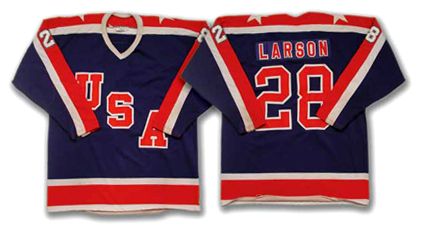
Finally, a brief interview with a jovial Larson at TCF Bank Stadium in advance of the Gophers up coming outdoor game against Ohio State in the 2014 Hockey City Classic.
Larson playing for the Minnesota Golden Gophers at the
St. Paul Civic Center,as evidenced by the unique clear dasherboards
The NCAA champion 1975-76 Minnesota Golden Gophers
Larson was drafted by the Minnesota Fighting Saints of the WHA and the Detroit Red Wings of the NHL, and following his final college game in 1977, he joined the Red Wings for the final 14 games of their schedule.
He began a run of nine seasons with 75 or more games played in 1977-78. Larson impressed that season with a stout 19 goals and 60 points. In 1978-79 he virtually duplicated that effort with 18 goals and 67 points as well as a career high 169 penalty minutes. He broke the 20 goal mark for the first time in 1979-80 with 22 goals on his way to 66 points. That was immediately followed in 1980-81 when Larson set a career high with 27 goals along with 58 assists and 153 penalty minutes. Additionally, Larson was named captain of the Red Wings that season.
Following the season, Larson made his only World Championship appearance when he skated for the United States at the 1981 Worlds, scoring 5 goals and 6 points in 8 games. Later than fall, he again answered the call for the United States as a member of their Canada Cup team, contributing a goal and an assist in 5 games.
From 1981-82 through 1983-84 Larson continued his run of 20 goals or more with 21, 22 and 23 goals, highlighted by his 1982-83 season when he set career highs with 52 assists and 74 points from the blueline.
Larson during the 1982-83 season, the only year
for the Red Wings unique ornate retro number font
Larson played 67 games of the 1985-86 season for the Red Wings until being traded to the Boston Bruins in March of 1986 for the final 13 games of the season.
Larson during his final season with Detroit when the Red Wings had
their 60th Anniversary logo embroidered into the upper right sleeve
He added another 12 goals to his career total in 1986-87, including scoring two goals on this date in 1987 to become the sixth defenseman and first American in NHL history to score 200 career goals in a 6-4 Bruins win over the Hartford Whalers.
Larson became the first American to score 200 goals while with the Bruins
In 1987-88, Larson played 62 games for the Bruins, scoring another 10 goals and 34 points. He also played the first minor league games of his entire career when he played two games for the Maine Mariners of the AHL on a conditioning assignment.
At this point the previous stability of Larson's career (12 seasons with two Original 6 clubs) came to and end and the nomadic phase began. He signed with the Edmonton Oilers as a free agent for the 1988-89 season, which lasted just 10 games. He was released by the Oilers and caught on as a free agent with the New York Islanders. He scored 7 goals and 20 points on Long Island in 33 games before being traded to his hometown Minnesota North Stars for the final 11 games of his well-travelled season.
Larson spent 33 games with the Islanders during 1988-89
He travelled even further in 1989-90 when he signed to play with HC Alleghe in Italy as a player-coach, where, in 34 games, Larson scored 17 goals and 49 points. With the shorter Italian season over, Larson returned to North America and signed as a free agent with the Buffalo Sabres, but only appeared in a single game, which would prove to be his last in the NHL.
He returned to Italy with Alleghe for 1990-91, scoring 51 points before joining HC Milano Saima for the 1991-92 season. For the following season, Larson became a member of HC Courmaosta of the Italian Second Division. Thanks to Larson's dominant form, scoring 30 goals and 78 points in 32 games, Courmaosta won promotion to the Italian top division, the Serie A and he moved up with the club, playing in 19 games, scoring 26 points to end the Italian period of his career.
Larson still had one final stop at home before calling it a career, suiting up for nine games for the Minnesota Moose of the IHL during the 1994-95 season before retiring from play.
Larson finished his career with the Minnesota Moose
His final NHL totals were 904 games played with 222 goals and 463 assists for 685 points. Larson also played in three NHL All-Star Games in 1978, 1980 and 1981 and was inducted into the United States Hockey Hall of Fame in 1996.
Today's featured jersey is a 1981-82 Detroit Red Wings Reed Larson jersey as worn during his first year as captain of the Red Wings when he set a career high with 27 goals on his way to becoming the first American to score 200 goals in the NHL.
Detroit adopted this style sweater 1932-33 when they changed their name from the Falcons to the Red Wings. There have been a few detail changes to the number font throughout the decades and the position of the white waist stripe, as well as the additions of sleeve numbers and names on the back, but the jersey has remained essentially unchanged for over 80 years.
This jersey can be dated to the 1981-82 season by the patch on the upper right chest honoring the Norris family's 50 years of ownership of the club.
Simple stars on the shoulders give it a touch of patriotism and the diagonal USA cresting is in the classic style of the New York Rangers, making for a simple, effective and attractive design has has stood the test of time with ease.

photo courtesy of Classic Auctions
Today's video section begins with Larson scoring a goal during the 1980 NHL All-Star Game.
Next, Larson and Kevin Maguire have a go from a game in December of 1987.
Finally, a brief interview with a jovial Larson at TCF Bank Stadium in advance of the Gophers up coming outdoor game against Ohio State in the 2014 Hockey City Classic.
Labels:
Detroit Red Wings,
Larson Reed,
USA
Thursday, January 14, 2016
1923-24 Montreal Canadiens Sprague Cleghorn Jersey
Brothers Odie Cleghorn and Sprague Cleghorn got their start in hockey playing in the Montreal City Hockey League in the 1908-09 season and then the pair joined the New York Wanderers of the United States Amateur Hockey Association the following season. Their performances, particularly that of Odie, who scored 15 goals in 8 games while Sprague had 7, drew the attention of a certain J. Ambrose O'Brien, who was bound and determined to win himself a Stanley Cup, and did so by hiring the very best that money could buy, dramatically overpaying a roster of players which became known as the Renfrew Millionaires.
The Cleghorn's were members of Renfrew for their second and final season of 1910-11, with Odie leading the way with 20 goals in 18 games while the rugged Sprague contributed 5 while anchoring the club's defense.
Sprague and Odie Cleghorn of the Renfrew Millionaires
With the Millionaires disbanded due to the realities of their untenable financial situation, the brothers returned home to Montreal to join the powerful Wanderers hockey club. The pair skated for the Wanderers for six seasons, from 1911-12 to 1916-17. Odie would score 115 goals in 103 games, with a high of 28 in just 18 games of the 1916-17 season, while Sprague was able to play enough at forward during his time with the Wanderers to score 79 goals, including a best of 21 in 1914-15, tying Odie for the year.
After missing the 1917-18 season due to World War I, a season which saw the Wanderers disband following the fire which burned their arena to the ground, the pair went their separate ways for 1918-19, with right winger Odie staying in Montreal, only now with the Canadiens, while his bodyguard Sprague joined the Ottawa Senators.
Sprague in the Senators barberpole sweater
Sprague played two seasons in Ottawa, racking up 16 goals in 21 games in 1919-20, as well as 85 penalty minutes in 21 games, a testament to his rough, if not downright dirty play. The Senators won the 1920 Stanley Cup by defeating the Seattle Metropolitans for the first championship for either brother. Sprague played the 1920-21 season with the Toronto St. Patricks, but After the St. Pats were eliminated from the playoffs, Sprague rejoined the Senators as a ringer for their five game series against the Vancouver Millionaires for the Stanley Cup, won by the Senators three games to two before he finally rejoined Odie with the Canadiens for the 1921-22 season.
Sprague while with the Toronto St. Patricks
Meanwhile, Odie had an excellent season in 1918-19 with 29 points (second in the NHL) and avoided tragedy while in Seattle for the 1919 Stanley Cup playoff against the Metropolitans when the series was permanently suspended due to an outbreak of the Influenza Epidemic, which claimed the life of teammate Bad Joe Hall.
Sprague rejoined his brother for the 1921-22 season when he returned to Montreal, now as a member of the Canadiens as well. Energized by his brother's return, Odie saw his goal total rise to 21, after being limited to just 5 the prior year. Sprague was also returned to playing forward after being a defenseman with the St. Pats, which saw his goal scoring rise to 17 from just 3 the previous season. As his brother's protector, Sprague saw his penalty minute total rise from 31 to 80 to lead the NHL for the season, far ahead of Corbett Denneny of Toronto's mere 28!
In the second period, Sprague took just 40 seconds to get his second of the game and completed his hat trick less than five minutes later to make the score 5-2 for Montreal. Odie's second arrived at the 13 minute mark and the teams again traded goals to finish out the period, with the Canadiens holding a commanding 7-3 lead.
The third period was more of the same, as Sprague once again came out flying, netting his fourth of the night at just 30 seconds. At 7 minutes, Odie's hat trick was now complete with a an assist from Sprauge once again. Joe Malone got his second of the game for the Tigers before Odie put the brothers into the record books with his fourth to match Sprague's total at 9:05, the first time two brothers had scored four goals each while members of the same team. Hamilton added two quick goals to make the final score 10-6 in favor of the Montreal and the Cleghorn's, led by Sprague's 4 goals and 6 points and Odie's 4 goals.
Two seasons later, Montreal would defeat the Senators for the NHL championship, then dispatched the Vancouver Maroons in two straight before sweeping the Calgary Tigers for the 1924 Stanley Cup championship, the only time the brothers would win one together. It was Sprague's third and Odie's first.
The 1924 World Champion Montreal Canadiens
They would play one more season together with Montreal before Oide finished his career by becoming coach of the Pittsburgh Pirates, which included occasionally playing in parts of three more seasons, while Sprague took his defensive abilities and rough play to the Boston Bruins for three seasons to end his NHL career.
Odie and Sprague during their final season in Montreal wearing their 1924-25 World's Champions sweaters
Odie played 17 NHA & NHL seasons, scoring 230 goals and 282 points in 300 games, winning one Stanley Cup. Meanwhile, Sprague, who also played 17 NHA & NHL seasons, scored 167 goals and 255 points in 374 games.
Sadly, Sprague was hit by a car in 1956 and died of his injuries on July 12th at the age of 66. Just hours before Sprague's funeral two days later on the 14th, Odie was found dead in his bed from heart failure at the age of 64.
Sprague was elected to the Hockey Hall of Fame in 1958.
Today's featured jersey is a 1923-24 Montreal Canadiens Sprague Cleghorn jersey. This sweater with the white "C" and red "H" was a short-lived variation, used only two seasons in 1922-23 and their Stanley Cup winning season of 1923-24. It was replaced by their commemorative World's Champions sweaters with the globe logo pictured above, while retaining the white "C" logo on the left arm for one season. In 1925-26 the "C" became red with a white outline and white "H", and with the addition of a second outline in blue in 1935, has remained unchanged ever since.
Today's video is a tribute to the 24 Stanley Cups won by le Club de hockey Canadien, the second of which included the brothers Cleghorn.
Labels:
Cleghorn Odie,
Cleghorn Sprague,
Montreal Canadiens
Wednesday, January 13, 2016
1910-11 Montreal Wanderers Art Ross Jersey
Born on this date in 1886, Art Ross moved to Montreal in 1902 at the age of 16 and played high school and junior hockey with hockey pioneers and innovators Frank and Lester Patrick. at Westmount Academy and then with the Montreal Westmount club in the Canadian Amateur Hockey League, the top amateur league in Canada, beginning with the 1902-03 season. He played with Westmount again in the 1903-04 season before joining the Montreal Merchants for the 1904-05 season where he scored 10 goals in 8 games.
He moved west in pursuit of a banking career but still had time for hockey, playing for the Brandon Wheat City club of the Manitoba Hockey League in 1905-06, scoring 6 times in 7 games. Ross was then added to the Kenora Thistles roster for their Stanley Cup challenge against the Montreal Wanderers, for which he was paid $1,000 for the two game series.
Teamed with the likes of future Hall of Famers Bad Joe Hall, Tommy Phillips and Tom Hooper, Kenora became the smallest town to ever win the Stanley Cup, as they defeated the Wanderers 4-2 and 8-6 to win the series 12 goals to 8 in the hostile territory of the Montreal Arena, which would figure in Ross' career later on as we shall see...
Ross moved back home to Montreal for the 1906-07 season and joined the very same Wanderers club he had helped dethrone as Stanley Cup holders, clearly having impressed the team management with his puck rushing style from his defensive position, a rarity in those days, as the defensemen of the day either fired the puck down the ice or deferred the forwards, passing it up to one at the first opportunity.
Thanks in part to his 8 goals in 10 games, the Wanderers would finish atop the Eastern Canada Amateur Hockey Association to retain the Stanley Cup they had won back from Kenora in a rematch two months after having lost it to the Thistles, of which Ross was not a part of. This would make Ross only the second player, after Jack Marshall, to win the cup two years in a row with two different clubs. Additionally, the Wanderers rebuffed challenges from the Ottawa Victorias, the Winnipeg Maple Leafs and the Toronto Argonauts that spring.
In January of 1908, Ross was a participant in the first all-star game in sports history, which was a benefit game for the family of the late Wanderers defender Hod Stuart, who drowned the previous summer.
For the 1908-09 season, Ross helped the Wanderers fend off another Stanley Cup challenge before the start of the regular season, a 13-10 defeat of the Edmonton Hockey Club. He scored twice in the Wanderers 9 games, but they lost the regular season title to the Ottawa Hockey Club and therefore their rights to the Stanley Cup. Ross was also hired by the Cobalt Silver Kings for a pair of playoff games, which they won to become Timiskaming Professional Hockey League champions.
It was back to Montreal for the 1909-10 season, this time with the All-Montreal Hockey Club as a player/manager in the upstart Canadian Hockey Association. Ross had scored 4 goals in 4 games before the league imploded in mid-January of 1910. Ross then caught on with the Haileybury Comets of the rival National Hockey Association, playing in 6 games and scoring 6 goals, which earned him $2,700.
Ross was lured back by the Wanderers, who were now members of the same NHA as Haileybury, for the 1910-11 season. He scored 4 times in 11 games and also enhanced his reputation as a tough player by knocking out the Quebec Bulldogs' Eddie Oatman, which started a massive brawl that required police intervention to break up!
The 1911-12 season saw Ross set a career high with 16 goals in 18 games followed by 11 goals in 19 games in 1912-13. After a salary dispute with the Wanderers, the two sides agreed to a new deal and Ross totaled 4 goals and 9 points in 1913-14.
Prior to the 1914-15 season, Ross attempted to persuade other players to leave their clubs and form a new league, which resulted in him being suspended. He responded by declaring himself a free agent. The president of the NHA then upped the suspension to cover all of organized hockey!
When is plan for a new league failed to gain traction, he applied to be reinstated to the NHA, which was granted in December 1914. The Wanderers were less than happy with Ross for the commotion and released him from the team. Ross then found a home with the Ottawa Senators.
Ottawa and the Wanderers finished with identical 14-6 records and a two game, total goal playoff was held to determine who would play the Pacific Coast Hockey Association's Vancouver Millionaires for the Stanley Cup. Ottawa won 4-0 in Game One and held off the Wanderers by despite a 1-0 loss in Game Two.
After scoring just 3 goals and 1 assist for Ottawa the previous season, Ross equaled a career high with 16 points in 1915-16 with 8 goals and 8 assists.
Somewhat surprisingly, following his acrimonious departure in 1914, Ross returned to Montreal and the Wanderers for the 1916-17 NHA season, in part to keep an eye on his Montreal sporting good store that he owned. He finished with 6 goals and 2 assists for the Wanderers in the final season for the NHA.
A new league was formed as part of some back room dealings, which brought an end to the NHA, but game rise to today's National Hockey League for 1917-18. In addition to his playing duties, Ross was also now the team's coach, but after just three games of the inaugural NHL season, the Wanderers aforementioned Montreal Arena was destroyed by a fire on January 2, 1918, which led to the financially struggling Wanderers folding their homeless franchise, which brought an abrupt end to Ross' playing days.
Ross managed to score but one goal in his three NHL games, but ironically, the league scoring championship trophy is named for the man who only scored once in his NHL career!
Ross remained active in hockey after his playing days concluded, which saw him coaching McGill University, becoming an NHL referee, coaching the Hamilton Tigers and then being hired by Charles Adams as the vice president, general manager, coach and scout for his NHL expansion franchise, which Ross himself dubbed the Boston Bruins.
In just five seasons, the Bruins, under Ross' leadership, rose from a 6-24 record to Stanley Cup champions. Ross became the first coach to ever pull his goalie late in a losing situation to gain an extra attacker in 1931. Before he retired in 1954 after 30 years with the club, the Bruins would win additional Stanley Cups in 1939 and 1941.
Ross was inducted into the Hockey Hall of Fame in 1949, specifically for his playing career, and not his long career as a team executive.
Today's featured jersey is a 1910-11 Montreal Wanderers Art Ross jersey. The Wanderers were formed in 1903 and were active until their arena burned down in 1918. All photographic records indicate the Wanderers wore the same white sweaters with a red band across the chest for their entire professional existence.
The Wanderers franchise finished first in the Federal Amateur Hockey League in 1904 before winning the ECHA championship in 1906 by defeating Ottawa in a two game, total goal playoff to capture the Stanley Cup.
They then won two more ECHA titles in 1907 and 1908 as well as turning away a challenge from the New Glasgow Cubs, winning back the Cup after losing it two months earlier to the Kenora Thistles, and then defending challenges for the cup from the Ottawa Victorias, Winnipeg Maple Leafs, Toronto Hockey Club and Edmonton Eskimos through March of 1909.
He moved west in pursuit of a banking career but still had time for hockey, playing for the Brandon Wheat City club of the Manitoba Hockey League in 1905-06, scoring 6 times in 7 games. Ross was then added to the Kenora Thistles roster for their Stanley Cup challenge against the Montreal Wanderers, for which he was paid $1,000 for the two game series.
Teamed with the likes of future Hall of Famers Bad Joe Hall, Tommy Phillips and Tom Hooper, Kenora became the smallest town to ever win the Stanley Cup, as they defeated the Wanderers 4-2 and 8-6 to win the series 12 goals to 8 in the hostile territory of the Montreal Arena, which would figure in Ross' career later on as we shall see...
The 1907 Stanley Cup champion Kenora Thistles
Ross moved back home to Montreal for the 1906-07 season and joined the very same Wanderers club he had helped dethrone as Stanley Cup holders, clearly having impressed the team management with his puck rushing style from his defensive position, a rarity in those days, as the defensemen of the day either fired the puck down the ice or deferred the forwards, passing it up to one at the first opportunity.
on several occasions throughout his career
Thanks in part to his 8 goals in 10 games, the Wanderers would finish atop the Eastern Canada Amateur Hockey Association to retain the Stanley Cup they had won back from Kenora in a rematch two months after having lost it to the Thistles, of which Ross was not a part of. This would make Ross only the second player, after Jack Marshall, to win the cup two years in a row with two different clubs. Additionally, the Wanderers rebuffed challenges from the Ottawa Victorias, the Winnipeg Maple Leafs and the Toronto Argonauts that spring.
In January of 1908, Ross was a participant in the first all-star game in sports history, which was a benefit game for the family of the late Wanderers defender Hod Stuart, who drowned the previous summer.
For the 1908-09 season, Ross helped the Wanderers fend off another Stanley Cup challenge before the start of the regular season, a 13-10 defeat of the Edmonton Hockey Club. He scored twice in the Wanderers 9 games, but they lost the regular season title to the Ottawa Hockey Club and therefore their rights to the Stanley Cup. Ross was also hired by the Cobalt Silver Kings for a pair of playoff games, which they won to become Timiskaming Professional Hockey League champions.
It was back to Montreal for the 1909-10 season, this time with the All-Montreal Hockey Club as a player/manager in the upstart Canadian Hockey Association. Ross had scored 4 goals in 4 games before the league imploded in mid-January of 1910. Ross then caught on with the Haileybury Comets of the rival National Hockey Association, playing in 6 games and scoring 6 goals, which earned him $2,700.
Ross was lured back by the Wanderers, who were now members of the same NHA as Haileybury, for the 1910-11 season. He scored 4 times in 11 games and also enhanced his reputation as a tough player by knocking out the Quebec Bulldogs' Eddie Oatman, which started a massive brawl that required police intervention to break up!
The 1911-12 season saw Ross set a career high with 16 goals in 18 games followed by 11 goals in 19 games in 1912-13. After a salary dispute with the Wanderers, the two sides agreed to a new deal and Ross totaled 4 goals and 9 points in 1913-14.
Prior to the 1914-15 season, Ross attempted to persuade other players to leave their clubs and form a new league, which resulted in him being suspended. He responded by declaring himself a free agent. The president of the NHA then upped the suspension to cover all of organized hockey!
When is plan for a new league failed to gain traction, he applied to be reinstated to the NHA, which was granted in December 1914. The Wanderers were less than happy with Ross for the commotion and released him from the team. Ross then found a home with the Ottawa Senators.
Ottawa and the Wanderers finished with identical 14-6 records and a two game, total goal playoff was held to determine who would play the Pacific Coast Hockey Association's Vancouver Millionaires for the Stanley Cup. Ottawa won 4-0 in Game One and held off the Wanderers by despite a 1-0 loss in Game Two.
The 1914-15 Ottawa Senators
After scoring just 3 goals and 1 assist for Ottawa the previous season, Ross equaled a career high with 16 points in 1915-16 with 8 goals and 8 assists.
Somewhat surprisingly, following his acrimonious departure in 1914, Ross returned to Montreal and the Wanderers for the 1916-17 NHA season, in part to keep an eye on his Montreal sporting good store that he owned. He finished with 6 goals and 2 assists for the Wanderers in the final season for the NHA.
A new league was formed as part of some back room dealings, which brought an end to the NHA, but game rise to today's National Hockey League for 1917-18. In addition to his playing duties, Ross was also now the team's coach, but after just three games of the inaugural NHL season, the Wanderers aforementioned Montreal Arena was destroyed by a fire on January 2, 1918, which led to the financially struggling Wanderers folding their homeless franchise, which brought an abrupt end to Ross' playing days.
that brought an end to Ross' playing career
Ross managed to score but one goal in his three NHL games, but ironically, the league scoring championship trophy is named for the man who only scored once in his NHL career!
only three games of the inaugural NHL season
Ross remained active in hockey after his playing days concluded, which saw him coaching McGill University, becoming an NHL referee, coaching the Hamilton Tigers and then being hired by Charles Adams as the vice president, general manager, coach and scout for his NHL expansion franchise, which Ross himself dubbed the Boston Bruins.
In just five seasons, the Bruins, under Ross' leadership, rose from a 6-24 record to Stanley Cup champions. Ross became the first coach to ever pull his goalie late in a losing situation to gain an extra attacker in 1931. Before he retired in 1954 after 30 years with the club, the Bruins would win additional Stanley Cups in 1939 and 1941.
Ross was inducted into the Hockey Hall of Fame in 1949, specifically for his playing career, and not his long career as a team executive.
Today's featured jersey is a 1910-11 Montreal Wanderers Art Ross jersey. The Wanderers were formed in 1903 and were active until their arena burned down in 1918. All photographic records indicate the Wanderers wore the same white sweaters with a red band across the chest for their entire professional existence.
The Wanderers franchise finished first in the Federal Amateur Hockey League in 1904 before winning the ECHA championship in 1906 by defeating Ottawa in a two game, total goal playoff to capture the Stanley Cup.
They then won two more ECHA titles in 1907 and 1908 as well as turning away a challenge from the New Glasgow Cubs, winning back the Cup after losing it two months earlier to the Kenora Thistles, and then defending challenges for the cup from the Ottawa Victorias, Winnipeg Maple Leafs, Toronto Hockey Club and Edmonton Eskimos through March of 1909.
Labels:
Montreal Wanderers,
Ross Art
Tuesday, January 12, 2016
1976-77 Cincinnati Stingers Dennis Sobchuk Jersey
After first playing 8 games for the Estevan Bruins of the Western Canadian Hockey League in 1970-71, scoring just one goal and one assist, Dennis Sobchuk, born on this date in 1954, joined the Regina Pats for the 1971-72 season and immediately led the team in scoring with 56 goals and 123 points, over 40 more than his closest teammate on his way to Rookie of the Year honors.
He would play two more seasons for the Pats, leading the club in scoring both seasons with first 67 goals and 147 points in 1972-73 and with 68 goals and 146 points in 1973-74, both times averaging a goal per game while also playing a strong defensive game. He also showed he was able to stand up to any challenge with 128 penalty minutes in 1972-73 on his way to becoming WCHL Player of the Year. He concluded his junior career in fine style, helping Regina win the 1974 Memorial Cup with 10 goals and 21 assists for 31 points in 16 playoff games.
While Sobchuk was drafted by the Philadelphia Flyers in the 1974 NHL Amateur Draft, players in the 1970's had options unknown to players prior to 1972, as the World Hockey Association arrived to challenge the NHL. Sobchuk signed with the Cincinnati Stingers of the WHA, no doubt influenced by the fact his brother was also signed by the Stingers and his father was a scout for the team. But in an unusual situation one could only expect to find in the crazy WHA, the Stingers had been granted a franchise, but their eventual home arena, the Riverfront Colosseum, was still under construction meaning the team would not begin play until the 1975-76 season!
Rather than let Sobchuk sit idle, he was loaned by the Stingers to the Phoenix Roadrunners for the 1974-75 season. He wasted no time adapting to the professional game, leading Phoenix in scoring with 32 goals and 77 points in 78 games.
With the Stingers now ready to take to the ice for the 1975-76 season, Sobchuk was recalled by Cincinnati, along with teammates John Hughes and his brother Gene Sobchuk. In 1976-77, he came third in team scoring with 32 goals and 72 points in 79 games. Despite raising his point totals to 44 goals and 96 points, both by far professional career highs, he again finished third in team scoring in the wide open WHA to Rich Leduc (107 points) and Blaine Stoughton (104). In one memorable day, Sobchuck and the Stingers were scheduled to play the Minnesota Fighting Saints, only the Houston Aeros came out to face them because Minnesota had folded that day!
Injuries began to take their toll on Sobchuk in the 1977-78 season, as he managed to play 23 games with the Stingers, scoring only 5 goals and 14 points before being traded to the Edmonton Oilers in a cost cutting move in December of 1977. Sobchuk would only manage to play in 13 games for the Oilers, scoring 6 goals and 9 points, before a devastating shoulder separation that would affect him for the rest of his career that curtailed his season after just 36 games and would lead to two more separations later in his career.
Sobchuk would spend the entire 1978-79 season with the Oilers, playing in 74 games with a partial return to his scoring ways with 26 goals and 63 points in what would prove to be the final season for the WHA.
Under the highly restrictive terms of the agreement that allowed four WHA clubs to join the NHL for the 1979-80 season, Sobchuk's rights were reclaimed by the Flyers, who had drafted him five years earlier. Philadelphia then traded Sobchuk's rights to the Detroit Red Wings.
Sobchuk failed to produce for Detroit, 4 goals and 10 points in 33 games, and was sent to their AHL affiliate, the Adirondack Red Wings, for the rest of the season.
The remainder of his career was an odd meandering path through the world of professional hockey, as he played 5 games for the Birmingham Bulls of the minor Central Hockey League and 19 games for EV Zug of the Swiss second division, scoring 24 goals.
He spent the entire 1981-82 season with Innsbruck EV in the top Austrian league. He returned to North America for the 1982-83 season, splitting his time between the Moncton Alpines of the AHL (20 games, 17 points), the Fredericton Express, also of the AHL (9 games, 12 points) and made a brief return to the NHL when he suited up for a pair of games for the Quebec Nordiques, scoring a lone goal.
Sobchuk returned to Innsbruck in Austria for the 1983-84 season, his last as a player. During his two seasons in Austria, Sobchuk totaled 42 goals and 95 points in 51 games.
Following his career, his 416 points in three seasons for Regina, which included leading the team in scoring all three seasons and winning a Memorial Cup, led to him having his #14 retired by the Pats, one of only six numbers retired by the club.
Today's featured jersey is a 1976-77 Cincinnati Stingers Dennis Sobchuk jersey as worn during Sobchuk's career year of 44 goals and 96 points. The Stingers wore the same jerseys for their entire four years of play, with the only change worth mentioning being changing from two color names for their first two seasons to one color black names for their final two.
Bonus jersey: Today's bonus jersey is a 1977 WHA All-Star Game Dennis Sobchuk jersey as worn during the 1977 edition held in Hartford, Connecticut when the East beat the West 4-2 with Sobchuk on the winning East side.
Extra bonus jersey: Today's extra bonus jersey is a 1983-84 Innsbruck EV Dennis Sobchuk jersey as worn during the latter stages of Sobchuk's career, which also turned out to be the final season of the Innsbruck EV franchise, which dated back to it's formation in 1925.
This jersey is typical of European jerseys of the era, with it's (difficult to see) adidas three stripes down the arms, large sponsorship logo on the front (from Raiffeisen Bank) and the cresting, name and numbers all made of a felt material including the very European block, drop-shadowed numbers, which remained in style through 1995.
He would play two more seasons for the Pats, leading the club in scoring both seasons with first 67 goals and 147 points in 1972-73 and with 68 goals and 146 points in 1973-74, both times averaging a goal per game while also playing a strong defensive game. He also showed he was able to stand up to any challenge with 128 penalty minutes in 1972-73 on his way to becoming WCHL Player of the Year. He concluded his junior career in fine style, helping Regina win the 1974 Memorial Cup with 10 goals and 21 assists for 31 points in 16 playoff games.
While Sobchuk was drafted by the Philadelphia Flyers in the 1974 NHL Amateur Draft, players in the 1970's had options unknown to players prior to 1972, as the World Hockey Association arrived to challenge the NHL. Sobchuk signed with the Cincinnati Stingers of the WHA, no doubt influenced by the fact his brother was also signed by the Stingers and his father was a scout for the team. But in an unusual situation one could only expect to find in the crazy WHA, the Stingers had been granted a franchise, but their eventual home arena, the Riverfront Colosseum, was still under construction meaning the team would not begin play until the 1975-76 season!
Rather than let Sobchuk sit idle, he was loaned by the Stingers to the Phoenix Roadrunners for the 1974-75 season. He wasted no time adapting to the professional game, leading Phoenix in scoring with 32 goals and 77 points in 78 games.
With the Stingers now ready to take to the ice for the 1975-76 season, Sobchuk was recalled by Cincinnati, along with teammates John Hughes and his brother Gene Sobchuk. In 1976-77, he came third in team scoring with 32 goals and 72 points in 79 games. Despite raising his point totals to 44 goals and 96 points, both by far professional career highs, he again finished third in team scoring in the wide open WHA to Rich Leduc (107 points) and Blaine Stoughton (104). In one memorable day, Sobchuck and the Stingers were scheduled to play the Minnesota Fighting Saints, only the Houston Aeros came out to face them because Minnesota had folded that day!
Injuries began to take their toll on Sobchuk in the 1977-78 season, as he managed to play 23 games with the Stingers, scoring only 5 goals and 14 points before being traded to the Edmonton Oilers in a cost cutting move in December of 1977. Sobchuk would only manage to play in 13 games for the Oilers, scoring 6 goals and 9 points, before a devastating shoulder separation that would affect him for the rest of his career that curtailed his season after just 36 games and would lead to two more separations later in his career.
Sobchuk would spend the entire 1978-79 season with the Oilers, playing in 74 games with a partial return to his scoring ways with 26 goals and 63 points in what would prove to be the final season for the WHA.
Under the highly restrictive terms of the agreement that allowed four WHA clubs to join the NHL for the 1979-80 season, Sobchuk's rights were reclaimed by the Flyers, who had drafted him five years earlier. Philadelphia then traded Sobchuk's rights to the Detroit Red Wings.
Sobchuk failed to produce for Detroit, 4 goals and 10 points in 33 games, and was sent to their AHL affiliate, the Adirondack Red Wings, for the rest of the season.
The remainder of his career was an odd meandering path through the world of professional hockey, as he played 5 games for the Birmingham Bulls of the minor Central Hockey League and 19 games for EV Zug of the Swiss second division, scoring 24 goals.
He spent the entire 1981-82 season with Innsbruck EV in the top Austrian league. He returned to North America for the 1982-83 season, splitting his time between the Moncton Alpines of the AHL (20 games, 17 points), the Fredericton Express, also of the AHL (9 games, 12 points) and made a brief return to the NHL when he suited up for a pair of games for the Quebec Nordiques, scoring a lone goal.
Sobchuk returned to Innsbruck in Austria for the 1983-84 season, his last as a player. During his two seasons in Austria, Sobchuk totaled 42 goals and 95 points in 51 games.
Following his career, his 416 points in three seasons for Regina, which included leading the team in scoring all three seasons and winning a Memorial Cup, led to him having his #14 retired by the Pats, one of only six numbers retired by the club.
Today's featured jersey is a 1976-77 Cincinnati Stingers Dennis Sobchuk jersey as worn during Sobchuk's career year of 44 goals and 96 points. The Stingers wore the same jerseys for their entire four years of play, with the only change worth mentioning being changing from two color names for their first two seasons to one color black names for their final two.
Bonus jersey: Today's bonus jersey is a 1977 WHA All-Star Game Dennis Sobchuk jersey as worn during the 1977 edition held in Hartford, Connecticut when the East beat the West 4-2 with Sobchuk on the winning East side.
Extra bonus jersey: Today's extra bonus jersey is a 1983-84 Innsbruck EV Dennis Sobchuk jersey as worn during the latter stages of Sobchuk's career, which also turned out to be the final season of the Innsbruck EV franchise, which dated back to it's formation in 1925.
This jersey is typical of European jerseys of the era, with it's (difficult to see) adidas three stripes down the arms, large sponsorship logo on the front (from Raiffeisen Bank) and the cresting, name and numbers all made of a felt material including the very European block, drop-shadowed numbers, which remained in style through 1995.
Labels:
Cincinnati Stingers,
Innsbruck EV,
Sobchuk Dennis,
WHA
Sunday, January 10, 2016
1974-75 Minnesota Fighting Saints Bill Butters Jersey
After attending White Bear Lake High School north of St. Paul, Bill Butters joined the University of Minnesota Golden Gophers for the 1969-70 season when he played on the freshman team. Butters, a defenseman, then moved up to the Gophers varsity squad for the 1970-71 season, playing in 27 games with 52 penalty minutes. After scoring just one lone assist in his first season, Butters scored his first NCAA goal and added 9 assists in 1971-72 while nearly doubling his penalty minutes to 100 while establishing himself as one of the toughest characters in the rugged WCHA, whose hits were remembered by all who were on the receiving end of them.
For the 1972-73 season under the guidance of new Gophers head coach Herb Brooks, Butters was named as captain of Minnesota. He increased his games played to 33 and his goal total to 3 as well as boosting his penalty minutes to 110.
Undrafted, Butters turned professional for the 1973-74 season with the Oklahoma City Blazers of the Central Hockey League where he saw action in 71 games, where he set career highs with 7 goals, 18 assists and 25 points. He also spent 174 minutes in the penalty box. Butters also added 2 goals and 6 assists in 10 playoff games as Oklahoma City made it to the league finals.
He began the 1974-75 season with the Blazers, but after amassing a whopping 192 penalty minutes in just 32 games, Butters returned to familiar territory in St. Paul when he signed with the Minnesota Fighting Saints of the World Hockey Association, a team which always seemed to have room for more toughness.
With the Fighting Saints, Butters played in 24 games while adding 58 penalty minutes to his season total while chipping in 2 goals and 4 points. He also added a goal in 12 playoff games for Minnesota while collecting another 21 penalty minutes.
He played in 59 games with the Fighting Saints in 1975-76 with 15 assists and 170 penalty minutes until the franchise folded in late February. Butters then finished the season with the rival Houston Aeros, no doubt becoming teammates with some of his former fight adversaries. Butters played in 14 regular season games for Houston plus an additional 17 playoff games as the Aeros made it to the Avco Cup Finals.
Bizarrely, Butters 1976-77 season was a nearly identical repeat of the previous season, as the Cleveland Crusaders franchise relocated to St. Paul and adopted the Minnesota Fighting Saints name and identity, only swapping the team's blue and yellow colors for red and yellow. Butters rights were traded by the Birmingham Bulls to Minnesota where he led the team with 133 penalty minutes, more than double that of his nearest teammate, Gord Gallant's 64. But once again, this time after just 42 games, the new Fighting Saints folded mid-season just like their predecessors.
Butters found a new home with the Edmonton Oilers, but after a mere 7 games, he and former Fighting Saints teammate Mike Antonovich were dealt to the New England Whalers for the remainder of the tumultuous 1976-77 season. While with the Whalers, Butters scored 9 points in 26 games and was whistled for 65 penalty minutes.
He began the 1977-78 season with New England and played in 45 games. He had a goal and 13 assists to go with his 69 penalty minutes before once again returning to his home state of Minnesota, only this time with the Minnesota North Stars of the NHL, who signed him as a free agent after clearing WHA waivers.
Butters played 23 games to finish the 1977-78 season. He was back with the North Stars for the 1978-79 season, playing in 49 games and scoring 4 assists as well as 47 penalty minutes. He also was sent to Minnesota's CHL affiliate, the Oklahoma City Stars, coincidentally located where his pro career began after college.
After playing 14 games to finish the 1978-79 season, Butters played one final season with Oklahoma City in 1979-80 where he played in 73 games, scoring 3 goals and 11 points as well as his customary 134 penalty minutes to close out his career. By spending the entire season with Oklahoma City, it would be the first time since his first pro season he would spend the entire year with the same club, thanks in large part to the instability of the WHA.
He would finish his career with over 100 fights and over 240 stitches in his face as he totaled 607 penalty minutes in 289 games, leaving behind a litany or stories about his off ice exploits and legendary tales of challenging other teams, which sometimes led to fights in the other team's bench or inside penalty boxes!
Following his playing days, Butters would be an assistant coach for the University of Minnesota from 1985 to 1995 and later the University of Wisconsin from 2010 to 2012 and is now heavily involved in Hockey Ministries International.
Today's featured jersey is a 1974-75 Minnesota Fighting Saints Bill Butters jersey as worn by the original incarnation of the Fighting Saints. After beginning their inaugural season with jerseys crested with a stylized letter "S", the Fighting Saints introduced the Little Saint logo when their new home, the St. Paul Civic Center was completed in January of 1973. They would continue to wear the same style until the franchise folded in 1976.
Bonus jersey:Today's bonus jersey is a 1976-77 Minnesota Fighting Saints Bill Butters jersey
as worn by the second incarnation of the Fighting Saints, created with the relocation of the Cleveland Crusaders.
The new Fighting Saints swapped out the original club's blue for red, but otherwise maintained the same identity for their brief 42 game run in the WHA before they too folded mid-season.
Bill Butters in a 1969-72 Gopher road jersey
For the 1972-73 season under the guidance of new Gophers head coach Herb Brooks, Butters was named as captain of Minnesota. He increased his games played to 33 and his goal total to 3 as well as boosting his penalty minutes to 110.
Butters was the Gophers team captain in 1972-73
in the first year of the Gophers new jersey style
Undrafted, Butters turned professional for the 1973-74 season with the Oklahoma City Blazers of the Central Hockey League where he saw action in 71 games, where he set career highs with 7 goals, 18 assists and 25 points. He also spent 174 minutes in the penalty box. Butters also added 2 goals and 6 assists in 10 playoff games as Oklahoma City made it to the league finals.
He began the 1974-75 season with the Blazers, but after amassing a whopping 192 penalty minutes in just 32 games, Butters returned to familiar territory in St. Paul when he signed with the Minnesota Fighting Saints of the World Hockey Association, a team which always seemed to have room for more toughness.
With the Fighting Saints, Butters played in 24 games while adding 58 penalty minutes to his season total while chipping in 2 goals and 4 points. He also added a goal in 12 playoff games for Minnesota while collecting another 21 penalty minutes.
He played in 59 games with the Fighting Saints in 1975-76 with 15 assists and 170 penalty minutes until the franchise folded in late February. Butters then finished the season with the rival Houston Aeros, no doubt becoming teammates with some of his former fight adversaries. Butters played in 14 regular season games for Houston plus an additional 17 playoff games as the Aeros made it to the Avco Cup Finals.
Bizarrely, Butters 1976-77 season was a nearly identical repeat of the previous season, as the Cleveland Crusaders franchise relocated to St. Paul and adopted the Minnesota Fighting Saints name and identity, only swapping the team's blue and yellow colors for red and yellow. Butters rights were traded by the Birmingham Bulls to Minnesota where he led the team with 133 penalty minutes, more than double that of his nearest teammate, Gord Gallant's 64. But once again, this time after just 42 games, the new Fighting Saints folded mid-season just like their predecessors.
Butters found a new home with the Edmonton Oilers, but after a mere 7 games, he and former Fighting Saints teammate Mike Antonovich were dealt to the New England Whalers for the remainder of the tumultuous 1976-77 season. While with the Whalers, Butters scored 9 points in 26 games and was whistled for 65 penalty minutes.
He began the 1977-78 season with New England and played in 45 games. He had a goal and 13 assists to go with his 69 penalty minutes before once again returning to his home state of Minnesota, only this time with the Minnesota North Stars of the NHL, who signed him as a free agent after clearing WHA waivers.
Butters played 23 games to finish the 1977-78 season. He was back with the North Stars for the 1978-79 season, playing in 49 games and scoring 4 assists as well as 47 penalty minutes. He also was sent to Minnesota's CHL affiliate, the Oklahoma City Stars, coincidentally located where his pro career began after college.
After playing 14 games to finish the 1978-79 season, Butters played one final season with Oklahoma City in 1979-80 where he played in 73 games, scoring 3 goals and 11 points as well as his customary 134 penalty minutes to close out his career. By spending the entire season with Oklahoma City, it would be the first time since his first pro season he would spend the entire year with the same club, thanks in large part to the instability of the WHA.
He would finish his career with over 100 fights and over 240 stitches in his face as he totaled 607 penalty minutes in 289 games, leaving behind a litany or stories about his off ice exploits and legendary tales of challenging other teams, which sometimes led to fights in the other team's bench or inside penalty boxes!
Following his playing days, Butters would be an assistant coach for the University of Minnesota from 1985 to 1995 and later the University of Wisconsin from 2010 to 2012 and is now heavily involved in Hockey Ministries International.
Today's featured jersey is a 1974-75 Minnesota Fighting Saints Bill Butters jersey as worn by the original incarnation of the Fighting Saints. After beginning their inaugural season with jerseys crested with a stylized letter "S", the Fighting Saints introduced the Little Saint logo when their new home, the St. Paul Civic Center was completed in January of 1973. They would continue to wear the same style until the franchise folded in 1976.
The new Fighting Saints swapped out the original club's blue for red, but otherwise maintained the same identity for their brief 42 game run in the WHA before they too folded mid-season.
Labels:
Butters Bill,
Minnesota Fighting Saints
Subscribe to:
Comments (Atom)

